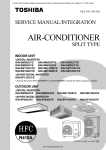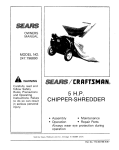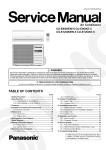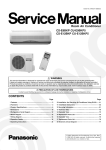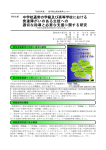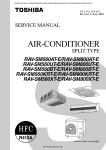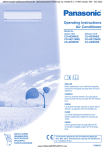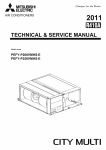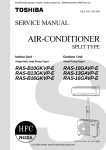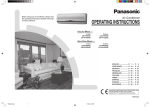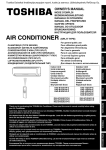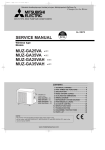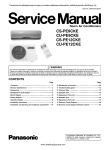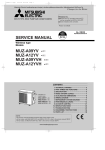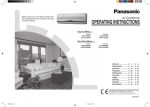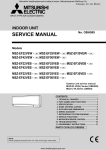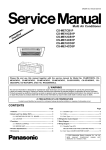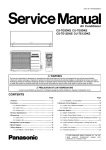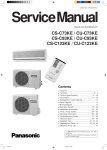Download Room Air Conditioner
Transcript
Panasonic ilmastointilaitteet korjaa ja huoltaa pääkaupunkiseudulla: Jäähdytinpalvelu RefGroup Oy Order Number: GMAC0311008C2 Room Air Conditioner CS-PV9CKE CU-PV9CKE CS-PV12CKE CU-PV12CKE CONTENTS Page Page 1 Functions 2 10 Servicing Information 42 2 Product Specifications 5 11 Troubleshooting Guide 46 3 Dimensions 9 12 Technical Data 48 4 Refrigeration Cycle Diagram 11 13 Exploded View 50 5 Block Diagram 12 14 Replacement Parts List 51 6 Wiring Diagram 13 15 Exploded View 52 7 Operation Details 14 16 Replacement Parts List 53 8 Installation Instructions 21 17 Electronic Circuit Diagram 54 9 Installation and Servicing Air Conditioner Using R410A 31 18 Electronic Circuit Diagram (Remote Control) 57 © Guangzhou Matsushita Air Conditioner Co., Ltd. (GMAC) All rights reserved. Unauthorized copying and distribution is a violation of law. www.ilmalämpöpumput.com CS-PV9CKE CU-PV9CKE / CS-PV12CKE CU-PV12CKE Panasonic ilmastointilaitteet korjaa ja huoltaa pääkaupunkiseudulla: Jäähdytinpalvelu RefGroup Oy 1 Functions Remote Control OFF / ON Room Temperature Setting Cooling, Soft Dry, Air Circulation Operation. • Temperature Setting (16oC to 30oC) MODE Operation Mode Selection • • • • FAN SPEED AUTO COOL DRY FAN FAN FAN FAN AUTO FAN Automatic Operation Operation with 2oC higher than • standard temperature. • Operation with standard temperature. Operation with 2oC lower than • standard temperature. Automatic Operation Mode Cooling Operation Mode Soft Dry Operation Mode Air Circulation Mode Indoor Fan Speed Selection • • • • AIR SWING TEMP. Operation OFF / ON Low Fan Speed Medium Fan Speed High Fan Speed Automatic Fan Speed ON-TIMER OFF-TIMER Timer Operation Selection • 24-hour, OFF / ON Real Timer Setting. TIME Time / Timer Setting • Hours and minutes setting. Vertical Airflow Direction Control • AUTO • MANUAL Automatic Vertical Airflow Direction Control Vertical Airflow Direction Manual Control (5 stages of adjustment) SET CANCEL Timer Operation Set / Cancel • ON Timer and OFF Timer setting and cancellation. RESET Reset Point • Press with a pin to clear the memory data. 2 www.ilmalämpöpumput.com CS-PV9CKE CU-PV9CKE / CS-PV12CKE CU-PV12CKE Panasonic ilmastointilaitteet korjaa ja huoltaa pääkaupunkiseudulla: Jäähdytinpalvelu RefGroup Oy Indoor Unit AUTO OFF / ON Automatic Operation Button • Press for < 5s to operate Automatic operation mode. (Used when the remote control cannot be used.) • Press continuously for 5s or < 10s to operate Test Run/Pump down. “Beep” sound will be heard at the 5th second. (Used when test running or servicing.) • Press continuously for 10s and above to omit or resume the remote control signal receiving sound. “Beep, beep” sound will be heard at the 10th second. Operation Indication Lamps (LED) • POWER(Green) ......... Lights up in operation, blinks in Automatic Operation Mode judging. • Random Auto Restart Control • Operation is restarted randomly after power failure at previous setting mode. Anti-Freezing Control • Anti-Freezing control for indoor heat exchanger. (Cooling and Soft Dry) Indoor Fan Speed Control • High, Medium and Low. • Automatic Fan Speed Mode – Cooling : Fan rotates at Hi, Me and SLo speed. Deodorizing control is available. – Soft Dry : Fan rotates at Lo- speed. Deodorizing control is available. TIMER(Orange) ......... Lights up in Timer Setting. Operation Mode • Cooling, Soft Dry, Air Circulation and Automatic Mode. Airflow Direction Control • Automatic air swing and manual adjusted by remote control for vertical airflow. • Manually adjusted by hand for horizontal airflow. Starting Current Control Powerful Operation • Reaches the desired room temperature quickly. • Fan motor is delayed for 1.6 seconds when compressor starts simultaneously. Time Delay Safety Control Quiet Operation • To provide extra quiet operation. • Restarting is inhibited for appro. 3 minutes. 7 Minutes Time Save Control • Cooling Operation only. 3 www.ilmalämpöpumput.com CS-PV9CKE CU-PV9CKE / CS-PV12CKE CU-PV12CKE Panasonic ilmastointilaitteet korjaa ja huoltaa pääkaupunkiseudulla: Jäähdytinpalvelu RefGroup Oy Outdoor Unit Compressor Reverse Rotation Protection Control • To protect compressor from reverse rotation when there is a instantaneous power failure. Overload Protector • 2-Stage OLP to protect the compressor. Overload Protector will trip when – Temperature of compressor increases to 120C. – High temperature or high current flows to compressor. (Refer circuit diagram for OLP characteristic) 60 Secs. Forced Operation Control • Once the compressor is activated, it does not stop within the first 60 secs. However, it stops immediately with remote control stop signal. Outdoor Fan Operation Control • There is a service port inside the outdoor unit. The port can be connected to a device which controls the outdoor fan motor when the cooling operation mode is used in cold winter. 4 www.ilmalämpöpumput.com CS-PV9CKE CU-PV9CKE / CS-PV12CKE CU-PV12CKE Panasonic ilmastointilaitteet korjaa ja huoltaa pääkaupunkiseudulla: Jäähdytinpalvelu RefGroup Oy 2 Product Specifications Unit CS-PV9CKE CU-PV9CKE Cooling Capacity kW 2.65 Moisture Removal L/h 1.60 Power Source Phase V Cycle Single 230 50 Airflow Method OUTLET SIDE VIEW TOP VIEW INTAKE Air Circulation Indoor Air (low) m3/min 5.8 — Indoor Air (medium) m3/min 6.7 — Indoor Air (high) m3/min 7.8 — Outdoor Air m3/min — 34.5 dB(A) High37, Low29 High50 Noise Level Electrical Data Input W 820 Running Current A 3.60 W/W 3.23 EER Starting Current Piping Connection Port (Flare piping) Piping Size (Flare piping) Drain Hose Inner Diameter Length Power Supply Cord Length (Number of core-wire) Dimensions Height Width Depth Net Weight Compressor A Inch Inch Inch Inch mm m m mm mm mm kg Type Motor Type Rated Output 16.5 G: half union 3/8" L: half union 1/4" G: gas side 3/8" L: liquid side 1/4" 12 0.6 1.9 3 core-wire/1.5mm 2 275 799 210 9.0 — W 5 www.ilmalämpöpumput.com — — G: 3-way valve 3/8" L: 2-way valve 1/4" G: gas side 3/8" L: liquid side 1/4" — — — — 540 780 289 31 Rotary(1 cylinder) Rolling piston type Induction(2 pole) 700 CS-PV9CKE CU-PV9CKE / CS-PV12CKE CU-PV12CKE Panasonic ilmastointilaitteet korjaa ja huoltaa pääkaupunkiseudulla: Jäähdytinpalvelu RefGroup Oy Unit Air Circulation Heat Exchanger Type Motor Type Input Rated Output Fan Speed Low Medium High Description Tube Material Fin Material Rows / Stage FPI Dimensions Refrigerant Control Device Refrigeration Oil Refrigerant (R410A) Thermostat Protection Device Capillary W W rpm rpm rpm mm (c.c) g Length Circulation Inner Diameter Air Filter Refrigerant Circulation Control Device Compressor Capacitor Fan Motor Capacitor mm L/min mm µFV µFV CS-PV9CKE CU-PV9CKE Cross-flow fan Propeller fan Induction (4 pole) Induction (6 pole) 47.4 58.4 15 30 940±30 — 1080±30 — 1260±30 820±30 Evaporator Condenser Copper Copper Slot Type Corrugation type (Plate fin configuration, forced draft) 2 × 10 1 × 20 21 18 610 × 210 × 25.4 841 × 504.6 × 12.7 — Capillary Tube — SUNISO 4GDID or ATMOS M60 (270) — 600 Electronic Control — — O.L.P.(230V20A/30A) — 803 — 8.5 — 1.4 P.P Honeycomb — Capillary — 30µF, 370V 1.5µF, 400V 2µF, 400V • Specifications are subject to change without notice for further improvement 6 www.ilmalämpöpumput.com CS-PV9CKE CU-PV9CKE / CS-PV12CKE CU-PV12CKE Panasonic ilmastointilaitteet korjaa ja huoltaa pääkaupunkiseudulla: Jäähdytinpalvelu RefGroup Oy Unit CS-PV12CKE CU-PV12CKE Cooling Capacity kW 3.52 Moisture Removal L/h 2.0 Power Source Phase V Cycle Single 230 50 Airflow Method OUTLET SIDE VIEW TOP VIEW INTAKE Air Circulation Indoor Air (low) m3/min 7.3 — Indoor Air (medium) m3/min 8.7 — Indoor Air (high) m3/min 10.2 — Outdoor Air m3/min — — dB(A) High40, Low31 High51 Noise Level Electrical Data Input W 1170 Running Current A 5.3 W/W 3.01 A 21.1 EER Starting Current Piping Connection Port (Flare piping) Piping Size (Flare piping) Drain Inner Diameter Hose Length Power Supply Cord Length (Number of core-wire) Dimensions Height Width Depth Net Weight Compressor Type Motor Type Rated Output Inch Inch Inch Inch mm m m mm mm mm kg G: half union 1/2" L: half union 1/4" G: gas side 1/2" L: liquid side 1/4" 12 0.6 1.9 3 core-wire/1.5mm 2 275 799 210 9.0 — W 7 www.ilmalämpöpumput.com — — G: 3-way valve 1/2" L: 2-way valve 1/4" G: gas side 1/2" L: liquid side 1/4" — — — — 540 780 289 31 Rotary(1 cylinder) Rolling piston type Induction(2 pole) 900 CS-PV9CKE CU-PV9CKE / CS-PV12CKE CU-PV12CKE Panasonic ilmastointilaitteet korjaa ja huoltaa pääkaupunkiseudulla: Jäähdytinpalvelu RefGroup Oy Unit Air Circulation Heat Exchanger Type Motor Type Input Rated Output Fan Speed Low Medium High Description Tube Material Fin Type Rows / Stage FPI Dimensions Refrigerant Control Device Refrigeration Oil Refrigerant (R410A) Thermostat Protection Device Capillary W W rpm rpm rpm mm (c.c) g Length Circulation Inner Diameter Air Filter Refrigerant Circulation Control Device Compressor Capacitor Fan Motor Capacitor mm L/min mm µFV µFV CS-PV12CKE CU-PV12CKE Cross-flow Fan Propeller fan Induction (4 pole) Induction (6 pole) 47.4 65.9 15 30 900±30 — 1080±30 — 1260±30 830±30 Evaporator Condenser copper copper slot type Corrugation type (Plate fin configuration, forced draft) 2 × 15 1 × 20 21 17 610 × 315 × 25.4 735 × 508.6 × 22 — Capillary Tube — SUNISO 4GDID or ATMOS M60 (430) — 890 Electronic Control Overload Protector — — 845 — 9.9 — 1.5 P.P Honeycomb — Capillary — 25µF, 370V 1.5µF, 400V 2µF, 400V • Specifications are subject to change without notice for further improvement. 8 www.ilmalämpöpumput.com CS-PV9CKE CU-PV9CKE / CS-PV12CKE CU-PV12CKE Panasonic ilmastointilaitteet korjaa ja huoltaa pääkaupunkiseudulla: Jäähdytinpalvelu RefGroup Oy 3 Dimensions 9 www.ilmalämpöpumput.com CS-PV9CKE CU-PV9CKE / CS-PV12CKE CU-PV12CKE Panasonic ilmastointilaitteet korjaa ja huoltaa pääkaupunkiseudulla: Jäähdytinpalvelu RefGroup Oy 10 www.ilmalämpöpumput.com CS-PV9CKE CU-PV9CKE / CS-PV12CKE CU-PV12CKE Panasonic ilmastointilaitteet korjaa ja huoltaa pääkaupunkiseudulla: Jäähdytinpalvelu RefGroup Oy 4 Refrigeration Cycle Diagram 11 www.ilmalämpöpumput.com CS-PV9CKE CU-PV9CKE / CS-PV12CKE CU-PV12CKE Panasonic ilmastointilaitteet korjaa ja huoltaa pääkaupunkiseudulla: Jäähdytinpalvelu RefGroup Oy 5 Block Diagram 12 www.ilmalämpöpumput.com CS-PV9CKE CU-PV9CKE / CS-PV12CKE CU-PV12CKE Panasonic ilmastointilaitteet korjaa ja huoltaa pääkaupunkiseudulla: Jäähdytinpalvelu RefGroup Oy 6 Wiring Diagram 13 www.ilmalämpöpumput.com CS-PV9CKE CU-PV9CKE / CS-PV12CKE CU-PV12CKE Panasonic ilmastointilaitteet korjaa ja huoltaa pääkaupunkiseudulla: Jäähdytinpalvelu RefGroup Oy 7 Operation Details 7.1. Cooling Mode Operation Cooling in operation according to Remote Control setting. Time Delay Safety Control (3 minutes) • When the compressor is stopped by Remote Control, it restarts after 3 minutes when the Remote Control is turned ON. • When the setting temperature is reached during cooling operation, the compressor stops and it will not start for 3 minutes. 7 minutes Time Save Control • The compressor will start automatically if it has stopped for 7 minutes even if the room temperature is between the compressor ON temperature and OFF temperature. Starting Current Control • When the compressor outdoor fan motor and indoor fan motor are simultaneously started, the indoor fan motor will operate 1.6 second later. Anti-Freezing Control • If the temperature of the indoor heat exchanger falls continuously below 2°C for 4 minutes or more, the compressor turns off to protect the indoor heat exchanger from freezing. The fan speed setting remains the same. • Compressor will restart again when the indoor heat exchanger temperature rises to 10°C (Recovery). 3 minutes waiting of Time Delay Safety Control is valid for Cooling Operation. Compressor Reverse Rotation Protection Control • If the compressor is operating continuously for 5 minutes or longer and the temperature difference between intake air and indoor heat exchanger is 2.5°C or less for 2 minutes, compressor will stop and restart automatically. (Time Delay Safety Control is valid) ! T = Intake air temperature - Indoor heat exchanger temperature This is to protect reverse rotation of the compressor when there is a instantaneous power failure. 14 www.ilmalämpöpumput.com CS-PV9CKE CU-PV9CKE / CS-PV12CKE CU-PV12CKE Panasonic ilmastointilaitteet korjaa ja huoltaa pääkaupunkiseudulla: Jäähdytinpalvelu RefGroup Oy Automatic Fan Speed Mode When Automatic Fan Speed is selected at Remote Control during cooling operation. • Fan speed rotates in the range of Hi to Me. • Deodorizing Control. Cooling Operation Time Diagram 15 www.ilmalämpöpumput.com CS-PV9CKE CU-PV9CKE / CS-PV12CKE CU-PV12CKE Panasonic ilmastointilaitteet korjaa ja huoltaa pääkaupunkiseudulla: Jäähdytinpalvelu RefGroup Oy 7.2. Soft Dry Mode Operation • The unit starts cooling operation until the room temperature reaches the setting temperature set on the Remote Control, and then Soft Dry operation will start. • During Soft Dry operation, the Indoor Fan will operate at Lo- speed. • The operation will be switched on and off for up to 10 minutes “ON” and 6 minutes “OFF”. Once Soft Dry operation is turned off, it stops for 6 minutes. Time Delay Safety Control • Once the compressor stops, it will not start for 3 minutes during Cooling operation. Starting Current Control • Same as Starting Current Control for Cooling Mode operation. Anti-Freezing Control • Same as Anti-Freezing Control for Cooling Mode operation. (For Soft Dry region, 6 minutes waiting is valid during compressor stops.) Compressor Reverse Rotation Protection Control • Same as Compressor Reverse Rotation Protection Control for Cooling Mode Operation. (For Soft Dry region, 6 minutes waiting is valid during compressor stops.) Automatic Fan Speed Mode When Automatic Fan Speed is selected at Remote Control during Soft Dry operation. • Fan speed off and on at Lo- speed. • Deodorizing Control. 16 www.ilmalämpöpumput.com CS-PV9CKE CU-PV9CKE / CS-PV12CKE CU-PV12CKE Panasonic ilmastointilaitteet korjaa ja huoltaa pääkaupunkiseudulla: Jäähdytinpalvelu RefGroup Oy Soft Dry Operation Time Diagram 17 www.ilmalämpöpumput.com CS-PV9CKE CU-PV9CKE / CS-PV12CKE CU-PV12CKE Panasonic ilmastointilaitteet korjaa ja huoltaa pääkaupunkiseudulla: Jäähdytinpalvelu RefGroup Oy 7.3. Air Circulation Mode Operation • When the temperature near the ceiling reaches the setting temperature, Air Circulation Mode operation commences at low airflow volume. It stops when the temperature drops to 2°C below the setting temperature. Air Circulation Mode Operation Time Diagram 7.4. Automatic Mode Operation Standard for Determining Operation Mode • Indoor fan operates at SLo fan speed for 20 seconds. • After judging indoor air temperature, the operation mode is determined and operation continued at the mode determined. • After the operation mode has been determined, the mode does not change. However, Soft Dry mode operation includes Cooling mode operation. • Room temperature adjustment. The following are added to the setting temperature specified as above. • The mode judging temperature and standard setting temperature can be increased by 2°C, by open the circuit of JX1 at indoor electronic controller. 18 www.ilmalämpöpumput.com CS-PV9CKE CU-PV9CKE / CS-PV12CKE CU-PV12CKE Panasonic ilmastointilaitteet korjaa ja huoltaa pääkaupunkiseudulla: Jäähdytinpalvelu RefGroup Oy 7.5. Random Auto Restart Control • If there is a power failure during air conditioner operation, operation will be automatically restarted after 3 to 4 minutes when the power is resumed. It will start with previous operation mode and airflow direction. • Restart time is decided randomly using 4 parameter:Intake air temperature, setting temperature, fan speed and Air Swing Blade position. • Auto Restart Control is not available when Timer is set. • This control can be omitted by open the circuit of JX2. (Refer Circuit Diagram) 7.6. Vertical Airflow Direction Control Vertical Airflow Direction Auto-Control • When set a Airflow Direction Auto-Control with remote control, the louver swings up and down as shown in the diagram. • The louver does not swing when the Indoor Fan Motor stops during operation at the upper limit. • When stopped with remote control, the discharge vent is reset, and stopped at the closing position. 1. There is no swinging while indoor fan motor is stopped during Cooling, Ion and Soft Dry operation. 2. In Air Circulation operation, when the intake air temperature reaches set temperature, the airflow direction is changed from upper limit to lower limit. When the intake air temperature falls to 2°C lower than set temperature, the airflow direction is changed from lower limit to upper limit. Vertical Airflow Direction manual Control • When the manual Airflow Direction Selection Button is pressed, the automatic airflow is released and the airflow direction louver move up and down in the range shown in the diagram. The louver can be adjusted by pressing the button to the desired louver position. • When the remote control is used to stop the operation, the discharge vent is reset, and stopped at the closing position. 19 www.ilmalämpöpumput.com CS-PV9CKE CU-PV9CKE / CS-PV12CKE CU-PV12CKE Panasonic ilmastointilaitteet korjaa ja huoltaa pääkaupunkiseudulla: Jäähdytinpalvelu RefGroup Oy 7.7. Delay ON Timer Control • When the Delayed ON Timer is set by using the remote control, the unit will start operate slightly before the set time, so that the room will reach nearly to the set temperature by the desired time. • For Cooling and Soft Dry mode, the operation will start 15 minutes before the set time. • For Automatic mode, the indoor fan will operate at SLo speed for 20 seconds, 15 minutes before the set time to detect the intake air temperature to determine the operation mode. The operation indication lamp will blink at this time. 7.8. Remote Control Signal Receiving Sound • Long beep sound will be heard when:− Stopping the Air Conditioner using ON/OFF switch. • Short beep sound will be heard for others. • To switch off the beep sound:Press the “Automatic Operation Button” continuously for 10 seconds or more (“beep” “beep” will be heard at the 10th second). Repeat the above if you want to switch ON the beep sound. However, if the “Automatic Operation Button” has been pressed the Automatic operation will be activated. If you do not require this operation, you may change it by using the remote control. 20 www.ilmalämpöpumput.com CS-PV9CKE CU-PV9CKE / CS-PV12CKE CU-PV12CKE Panasonic ilmastointilaitteet korjaa ja huoltaa pääkaupunkiseudulla: Jäähdytinpalvelu RefGroup Oy 8 Installation Instructions Required tools for Installation Works 5. Spanner 9. Gas leak detector 6. Pipe cutter 10. Measuring tape 1. Philips screw driver 2. Level gauge 3. Electric drill, hole core drill (ø70 mm) 4. Hexagonal wrench (4 mm) 8.1. 7. Reamer 11. Thermometer 13. Multimeter 14. Torque wrench 18 N.m (1.8 kgf.m) 42 N.m (4.2 kgf.m) 55 N.m (5.5 kgf.m) 15. Vacuum pump 8. Knife 12. Megameter 16. Gauge manifold Safety Precautions • Read the following “SAFETY PRECAUTIONS” carefully before installation. • Electrical work must be installed by a licensed electrician. Be sure to use the correct rating of the power plug and main circuit for the model to be installed. • The caution items stated here must be followed because these important contents are related to safety. The meaning of each indication used is as below. Incorrect installation due to ignoring of the instruction will cause harm or damage, and the seriousness is classified by the following indications. This indication shows the possibility of causing death or serious injury. This indication shows the possibility of causing injury or damage to properties only. The items to be followed are classified by the symbols: Symbol with background white denotes item that is PROHIBITED from doing. • Carry out test running to confirm that no abnormality occurs after the installation. Then, explain to user the operation, care and maintenance as stated in instructions. Please remind the customer to keep the operating instructions for future reference. 1. Engage dealer or specialist for installation. If installation done by the user is defective, it will cause water leakage, electrical shock or fire. 2. Install according to this installation instruction strictly. If installation is defective, it will cause water leakage, electrical shock or fire. 3. Use the attached accessories parts and specified parts for installation. Otherwise, it will cause the set to fall, water leakage, fire or electrical shock. 4. Install at a strong and firm location which is able to withstand the set’s weight. If the strength is not enough or installation is not properly done, the set will drop and cause injury. 5. For electrical work, follow the local national wiring standard, regulation and this installation instruction. An independent circuit and single outlet must be used. If electrical circuit capacity is not enough or defect found in electrical work, it will cause electrical shock or fire. 6. Use the specified cable (1.5 mm 2) and connect tightly for indoor/outdoor connection. Connect tightly and clamp the cable so that no external force will be acted on the terminal. If connection or fixing is not perfect, it will cause heat-up or fire at the connection. 7. Wire routing must be properly arranged so that control board cover is fixed properly. If control board cover is not fixed perfectly, it will cause heat-up at connection point of terminal, fire or electrical shock. 8. When carrying out piping connection, take care not to let air substances other than the specified refrigerant go into refrigeration cycle. Otherwise, it will cause lower capacity, abnormal high pressure in the refrigeration cycle, explosion and injury. 9. When connecting the piping, do not allow air or any substances other than the specified refrigerant (R410A) to enter the refrigeration cycle. Otherwise, this may lower the capacity, cause abnormally high pressure in the refrigeration cycle, and possibly result in explosion and injury. 10. • When connecting the piping, do not use any existing (R22) pipes and flare nuts. Using such same may cause abnormally high pressure in the refrigeration cycle (piping), and possibly result in explosion and injury. Use only R410A materials. • Thickness of copper pipes used with R410A must be more than 0.8 mm. Never use copper pipes thinner than 0.8 mm. • It is desirable that the amount of residual oil is less than 40 mg/10 m. 11. Do not modify the length of the power supply cord or use of the extension cord, and do not share the single outlet with other electrical appliances. Otherwise, it will cause fire or electrical shock. 21 www.ilmalämpöpumput.com CS-PV9CKE CU-PV9CKE / CS-PV12CKE CU-PV12CKE Panasonic ilmastointilaitteet korjaa ja huoltaa pääkaupunkiseudulla: Jäähdytinpalvelu RefGroup Oy 1. The equipment must be earthed. It may cause electrical shock if grounding is not perfect. 2. Do not install the unit at place where leakage of flammable gas may occur. In case gas leaks and accumulates at surrounding of the unit, it may cause fire. 3. Carry out drainage piping as mentioned in installation instructions. If drainage is not perfect, water may enter the room and damage the furniture. 1. Selection of the installation location. Select a installation location which is rigid and strong enough to support or hold the unit, and select a location for easy maintenance. 2. Power supply connection to the room air conditioner. Connect the power supply cord of the room air conditioner to the mains using one of the following method. Power supply point shall be the place where there is ease for access for the power disconnection in case of emergency. In some countries, permanent connection of this room air conditioner to the power supply is prohibited. 1. Power supply connection to the receptacle using a power plug. Use an approved 15A/16A power plug with earth pin for the connection to the socket. 2. Power supply connection to a circuit breaker for the permanent connection. Use an approved 16A circuit breaker for the permanent connection. It must be a double pole switch with a minimum 3 mm contact gap. 3. Do not release refrigerant. Do not release refrigerant during piping work for installation, reinstallation and during repairing a refrigeration parts. Take care of the liquid refrigerant, it may cause frostbite. 4. Installation work. It may need two people to carry out the installation work. 5. Do not install this appliance in a laundry room or other location where water may drip from the ceiling, etc. 22 www.ilmalämpöpumput.com CS-PV9CKE CU-PV9CKE / CS-PV12CKE CU-PV12CKE Panasonic ilmastointilaitteet korjaa ja huoltaa pääkaupunkiseudulla: Jäähdytinpalvelu RefGroup Oy Attached accessories Indoor/Outdoor Unit Installation Diagram SELECT THE BEST LOCATION INDOOR UNIT • There should not be any heat source or steam near the unit. • There should not be any obstacles blocking the air circulation. • A place where air circulation in the room is good. • A place where drainage can be easily done. • A place where consideration. noise prevention is taken into • Do not install the unit near the door way. • Ensure the spaces indicated by arrows from the wall, ceiling, fence or other obstacles. • Recommended installation height for indoor unit shall be at least 2.3 m. OUTDOOR UNIT • If an awning is built over the unit to prevent direct sunlight or rain, be careful that heat radiation from the condenser is not obstructed. • There should not be any animal or plant which could be affected by hot air discharged. • Keep the spaces indicated by arrows from wall, ceiling, fence or other obstacles. • Do not place any obstacles which may cause a short circuit of the discharged air. • If piping length is over the common length, additional refrigerant should be added as shown in the table. • This illustration is for explanation purposes only. The indoor unit will actually face a different way. 23 www.ilmalämpöpumput.com CS-PV9CKE CU-PV9CKE / CS-PV12CKE CU-PV12CKE Panasonic ilmastointilaitteet korjaa ja huoltaa pääkaupunkiseudulla: Jäähdytinpalvelu RefGroup Oy 8.2. INDOOR UNIT 8.2.1. SELECT THE BEST LOCATION (Refer to “Select the best location” section) 8.2.2. HOW TO FIX INSTALLATION PLATE 8.2.3. TO DRILL A HOLE IN THE WALL AND INSTALL A SLEEVE OF PIPING 1. Insert the piping sleeve to the hole. 2. Fix the bushing to the sleeve. 3. Cut the sleeve until it extrudes about 15 mm from the wall. The mounting wall is strong and solid enough to prevent it from the vibration. Caution When the wall is hollow, please be sure to use the sleeve for tube ass’y to prevent dangers caused by mice biting the connecting cable. 4. Finish by sealing the sleeve with putty or caulking compound at the final stage. The centre of installation plate should be at more than 450 mm at right and left of the wall. The distance from installation plate edge to ceiling should more than 67 mm. From installation plate left edge to unit’s left side is 47 mm. From installation plate right edge to unit’s right is 73 mm. : For left side piping, piping connection for liquid should be about 14 mm from this line. : For left side piping, piping connection for gas should be about 56 mm from this line. : For left side piping, piping connecting cable should be about 785 mm from this line. 8.2.4. INDOOR UNIT INSTALLATION 1. For the right rear piping 1. Mount the installation plate on the wall with 5 screws or more. (If mounting the unit on the concrete wall consider using anchor bolts.) • Always mount the installation plate horizontally by aligning the marking-off line with the thread and using a level gauge. 2. Drill the piping plate hole with ø70 mm hole-core drill. • Line according to the arrows marked on the lower left and right side of the installation plate. The meeting point of the extended line is the centre of the hole. Another method is by putting measuring tape at position as shown in the diagram above. The hole centre is obtained by measuring the distance namely 150 mm and 125 mm for left and right hole respectively. 2. For the right and right bottom piping • Drill the piping hole at either the right or the left and the hole should be slightly slanted to the outdoor side. 24 www.ilmalämpöpumput.com CS-PV9CKE CU-PV9CKE / CS-PV12CKE CU-PV12CKE Panasonic ilmastointilaitteet korjaa ja huoltaa pääkaupunkiseudulla: Jäähdytinpalvelu RefGroup Oy 3. For the embedded piping (This can be used for left rear piping & left bottom piping also.) 25 www.ilmalämpöpumput.com CS-PV9CKE CU-PV9CKE / CS-PV12CKE CU-PV12CKE Panasonic ilmastointilaitteet korjaa ja huoltaa pääkaupunkiseudulla: Jäähdytinpalvelu RefGroup Oy 8.2.5. CONNECT THE CABLE TO THE INDOOR UNIT 1. The inside and outside connecting cable can be connected without removing the front grille. 2. Connecting cable between indoor unit and outdoor unit shall be approved polychloroprene sheathed 3 × 1.5 mm2 flexible cord, type designation 245 IEC 57 or heavier cord. • Ensure the color of wires of outdoor unit and the terminal Nos. are the same to the indoor’s respectively. • Earth lead wire shall be longer than the other lead wires as shown in the figure for the electrical safety in case of the slipping out of the cord from the anchorage. • Secure the cable onto the control board with the holder (clamper). 26 www.ilmalämpöpumput.com CS-PV9CKE CU-PV9CKE / CS-PV12CKE CU-PV12CKE Panasonic ilmastointilaitteet korjaa ja huoltaa pääkaupunkiseudulla: Jäähdytinpalvelu RefGroup Oy HOW TO TAKE OUT FRONT GRILLE Please follow the steps below to take out front grille if necessary such as when servicing. 8.3. 8.3.1. SELECT THE BEST LOCATION (Refer to “Select the best location” section) 8.3.2. INSTALL THE OUTDOOR UNIT 1. Set the vertical airflow direction louver to the horizontal position. 2. Slide down the two caps on the front grille as shown in the illustration below, and then remove the two mounting screws. 3. Pull the lower section of the front grille towards you to remove the front grille. When reinstalling the front grille, first set the vertical airflow direction louver to the horizontal position and then carry out above steps 2 - 3 in the reverse order. OUTDOOR UNIT • After selecting the best location, start installation according to Indoor/Outdoor Unit Installation Diagram. 1. Fix the unit on concrete or rigid frame firmly and horizontally by bolt nut. (ø10 mm). 2. When installing at roof, please consider strong wind and earthquake. Please fasten the installation stand firmly with bolt or nails. 8.3.3. AUTO SWITCH OPERATION The below operations will be performed by pressing the “AUTO” switch. 1. AUTO OPERATION MODE The Auto operation will be activated immediately once the Auto Switch is pressed. 2. TEST RUN OPERATION (FOR PUMP DOWN/SERVICING PURPOSE) The Test Run operation will be activated if the Auto Switch is pressed continuously for more than 5 sec. to below 10 sec.. A “pep” sound will occur at the fifth sec., in order to identify the starting of Test Run operation 3. REMOTE CONTROLLER RECEIVING SOUND ON/OFF The ON/OFF of Remote Controller receiving sound can be change over by pressing the “AUTO” Switch continuously for 10 sec. and above. A “pep”, “pep” sound will occur at the tenth sec., in order to indicate the “ON/OFF” change over of remote control receiving sound. CONNECTING THE PIPING Connecting The Piping To Indoor Unit Please make flare after inserting flare nut (locate at joint portion of tube assembly) onto the copper pipe. (In case of using long piping) Connect the piping • Align the center of piping and sufficiently tighten the flare nut with fingers. • Further tighten the flare nut with torque wrench in specified torque as stated in the table. MODEL CS/CU-PV9CKE CS/CU-PV12CKE Piping size (Torque) Gas Liquid 3/8” (42 N.m) 1/4” (18 N.m) 1/2” (55 N.m) 1/4” (18 N.m) Connecting The Piping To Outdoor Unit Decide piping length and then cut by using pipe cutter. Remove burrs from cut edge. Make flare after inserting the flare nut (located at valve) onto the copper pipe. Align center of piping to valves and then tighten with torque wrench to the specified torque as stated in the table. 27 www.ilmalämpöpumput.com CS-PV9CKE CU-PV9CKE / CS-PV12CKE CU-PV12CKE Panasonic ilmastointilaitteet korjaa ja huoltaa pääkaupunkiseudulla: Jäähdytinpalvelu RefGroup Oy CUTTING AND FLARING THE PIPING 1. Please cut using pipe cutter and then remove the burrs. 2. Remove the burrs by using reamer. If burrs is not removed, gas leakage may be caused. Turn the piping end down to avoid the metal powder entering the pipe. 3. Please make flare after inserting the flare nut onto the copper pipes. 8.3.4. (a) EVACUATION OF THE EQUIPMENT (FOR EUROPE & OCEANIA DESTINATION) WHEN INSTALLING AN AIR CONDITIONER, BE SURE TO EVACUATE THE AIR INSIDE THE INDOOR UNIT AND PIPES in the following procedure. 1. Connect a charging hose with a push pin to the Low side of a charging set and the service port of the 3-way valve. • Be sure to connect the end of the charging hose with the push pin to the service port. 2. Connect the center hose of the charging set to a vacuum pump with check valve, or vacuum pump and vacuum pump adaptor. 3. Turn on the power switch of the vacuum pump and make sure that the needle in the gauge moves from 0 cmHg (0 MPa) to -76 cmHg (-0.1 MPa). Then evacuate the air approximately ten minutes. 4. Close the Low side valve of the charging set and turn off the vacuum pump. Make sure that the needle in the gauge does not move after approximately five minutes. Note: BE SURE TO FOLLOW THIS PROCEDURE IN ORDER TO AVOID REFRIGERANT GAS LEAKAGE. 5. Disconnect the charging hose from the vacuum pump and from the service port of the 3-way valve. 6. Tighten the service port caps of the 3-way valve at torque of 18 N.m with a torque wrench. 7. Remove the valve caps of both of the 2-way valve and 3-way valve. Position both of the valves to “OPEN” using a hexagonal wrench (4 mm). 8. Mount valve caps onto the 2-way valve and the 3-way valve. • Be sure to check for gas leakage. CAUTION • If gauge needle does not move from 0 cmHg (0 MPa) to -76 cmHg (-0.1 MPa), in step 3 above take the following measure: • If the leak stops when the piping connections are tightened further, continue working from step 3. • If the leak does not stop when the connections are retightened, repair the location of leak. • Do not release refrigerant during piping work for installation and reinstallation. Take care of the liquid refrigerant, it may cause frostbite. 28 www.ilmalämpöpumput.com CS-PV9CKE CU-PV9CKE / CS-PV12CKE CU-PV12CKE Panasonic ilmastointilaitteet korjaa ja huoltaa pääkaupunkiseudulla: Jäähdytinpalvelu RefGroup Oy 8.3.5. (b) AIR PURGING OF THE PIPING AND INDOOR UNIT The remaining air in the Refrigeration cycle which contains moisture may cause malfunction on the compressor. 1. Remove the caps from the 2-way and 3-way valves. 2. Remove the service-port cap from the 3-way valves. 3. To open the valve, turn the valve stem of 2-way valve counter-clockwise approx. 90° and hold it there for ten seconds, then close it. 4. Check gas-leakage of the connecting portion of the pipings. For the left pipings, refer to item 4(A). 5. To open 2-way valve again, turn the valve stem counter-clockwise until it stops. 4(A). Checking gas leakage for the left piping. (1) * Connect the manifold gauge to the service port of 3-way * valve. Measure the pressure. 8.3.6. (2) * Keep it for 5-10 minutes. Ensure that the pressure indicated on the gauge is the * same as that of measured during the first time. CONNECT THE CABLE TO THE OUTDOOR UNIT 1. Remove the control board cover from the unit by loosening the screw. 2. Connecting cable between indoor unit and outdoor unit shall be approved polychloroprene sheathed 3 × 1.5 mm2 flexible cord, type designation 245 IEC 57 or heavier cord. 3. Secure the cable onto the control board with the holder (clamper). 4. Attach the control board cover back to the original position with the screw. 8.3.7. PIPE INSULATION 1. Please carry out insulation at pipe connection portion as mentioned in Indoor/Outdoor Unit Installation Diagram. Please wrap the insulated piping end to prevent water from going inside the piping. 2. If drain hose or connecting piping is in the room (where dew may form), please increase the insulation by using POLY-E FOAM with thickness 6 mm or above. 29 www.ilmalämpöpumput.com CS-PV9CKE CU-PV9CKE / CS-PV12CKE CU-PV12CKE Panasonic ilmastointilaitteet korjaa ja huoltaa pääkaupunkiseudulla: Jäähdytinpalvelu RefGroup Oy CHECK THE DRAINAGE CHECK ITEMS • Open front panel and remove air filters. (Drainage checking can be carried out without removing the front grille.) • Pour a glass of water into the drain tray-styrofoam. • Ensure that water flows out from drain hose of the indoor unit. Is there any gas leakage at flare nut connections? Has the heat insulation been carried out at flare nut connection? Is the connecting cable being fixed to terminal board firmly? Is the connecting cable being clamped firmly? Is the drainage OK? (Refer to “Check the drainage” section) Is the earth wire connection properly done? Is the indoor unit properly hooked to the installation plate? Is the power supply voltage complied with rated value? EVALUATION OF THE PERFORMANCE Is there any abnormal sound? • Operate the unit at cooling operation mode for fifteen minutes or more. Is the cooling operation normal? • Measure the temperature of the intake and discharge air. Is the thermostat operation normal? • Ensure the difference between the intake temperature and the discharge is more than 8°C. Is the remote control’s LCD operation normal? Is the air purifying filter installed? 30 www.ilmalämpöpumput.com CS-PV9CKE CU-PV9CKE / CS-PV12CKE CU-PV12CKE Panasonic ilmastointilaitteet korjaa ja huoltaa pääkaupunkiseudulla: Jäähdytinpalvelu RefGroup Oy 9 Installation and Servicing Air Conditioner Using R410A 9.1. OUTLINE 9.1.1. About R410A Refrigerant 1. Converting air conditioners to R410A Since it was declared in1974 that chlorofluorocarbons (CFC), hydro chlorofluorocarbons (HCFC) and other substances pose a destructive danger to the ozone layer in the earth´s upper stratosphere (20 to 40 km above the earth), measures have been taken around the world to prevent this destruction. The R22 refrigerant which has conventionally been used in ACs is an HCFC refrigerant and, therefore, possesses this ozonedestroying potential. International regulations (the Montreal Protocol Ozone-Damaging Substances) and the domestic laws of various countries call for the early substitution of R22 by a refrigerant which will not harm the ozone layer. • In ACs, the HFC refrigerant which has become the mainstream alternative called R410A.Compared with R22, the pressure of R410A is approximately 1.6 times as high at the same refrigerant temperature, but the energy efficiency is about the same. Consisting of hydrogen (H), fluorine (F) and carbon (C), R410A is an HFC refrigerant. Another typical HFC refrigerant is R407C. While the energy efficiency of R407C is some what inferior to that of R410A, it offers the advantage of having pressure characteristics which are about the same as those of R22, and is used mainly in packaged ACs. 2. The characteristics of HFC (R410A) refrigerants a. Chemical characteristics The chemical characteristics of R410A are similar to those of R22 in that both are chemically stable, non-flammable refrigerants with low toxicity. However, just like R22, the specific gravity of R410A gas is heavier than that of air. Because of this, it can cause an oxygen deficiency if it leaks into a closed room since it collects in the lower area of the room. It also generates toxic gas when it is directly exposed to a flame, so it must be used in a well ventilated environment where it will not collect. Composition (wt%) Boiling point (°C) Vaporizing pressure (25°C) Saturated vapor density Flammability Ozone-destroying point (ODP) Global-warming point (GWP) Table 1 Physical comparison of R410A and R22 R410A R32/R125 (50/50) -51.4 1.56 Mpa (15.9 kgf/cm2) 64.0 kg/m3 Non-flammable 0 1730 R22 R22 (100) -40.8 0.94 Mpa (9.6 kgf/cm2) 44.4 kg/m3 Non-flammable 0.005 1700 b. Compositional change (pseudo-azeotropic characteristics) R410A is a pseudo-azeotropic mixture comprising the two components R32 and R125. Multi-component refrigerants with these chemical characteristics exhibit little compositional change even from phase changes due to vaporization or condensation), which means that there is little change in the circulating refrigerant composition even when the refrigerant leaks from the gaseous section of the piping. Accordingly, R410A can be handled in almost the same manner as the single-component refrigerant R22. However, when charging, because there is a slight change in composition between the gas phase and the liquid phase inside a cylinder or other container, charging should basically begin with the liquid side. c. Pressure characteristics As seen in Table 2, the gas pressure of R410A is approximately 1.6 times as high as that of R22 at the same refrigerant temperature, which means that special R410A tools and materials with high-pressure specifications must be used for all refrigerant piping work and servicing. Table 2 Comparison of R410A and R22 saturated vapor density Unit: MPa Refrigerant Temperature (°C) R410A -20 0.30 0 0.70 20 1.35 40 2.32 60 3.73 65 4.15 31 www.ilmalämpöpumput.com R22 0.14 0.40 0.81 1.43 2.33 2.60 CS-PV9CKE CU-PV9CKE / CS-PV12CKE CU-PV12CKE Panasonic ilmastointilaitteet korjaa ja huoltaa pääkaupunkiseudulla: Jäähdytinpalvelu RefGroup Oy d. R410A refrigerating machine oil Conventionally, mineral oil or a synthetic oil such as alkylbenzene has been used for R22 refrigerating machine oil. Because of the poor compatibility between R410A and conventional oils like mineral oil, however, there is a tendency for the refrigerating machine oil to collect in the refrigerating cycle. For this reason, polyester and other synthetic oils which have a high compatibility with R410A are used as refrigerating machine oil. Because of the high hygroscopic property of synthetic oil, more care must be taken in its handling than was necessary with conventional refrigerating machine oils. Also, these synthetic oils will degrade if mixed with mineral oil or alkylbenzene, causing clogging in capillary tubes or compressor malfunction. Do not mix them under any circumstances. 9.1.2. Safety Measure When Installing / Receiving Refrigerant Piping Cause the gas pressure of R410A is approximately 1.6 times as high as that of R22, a mistake in installation or servicing could result in a major accident. It is essential that you use R410a tools and materials, and that you observe the following precautions to ensure safety. 1. Do not use any refrigerant other than R410A in ACs that have been used with R410A. 2. If any refrigerant gas leaks while you are working, ventilate the room. Toxic gas may be generated if refrigerant gas is exposed to a direct flame. 3. When installing or transferring an AC, do not allow any air or substance other than R410A to mix into the refrigeration cycle. If it does, the pressure in the refrigeration cycle can become abnormally high, possibly causing an explosion and/or injury. 4. After finishing the installation, check to make sure there is no refrigerant gas leaking. 5. When installing or transferring an AC, follow the instructions in the installation instructions carefully. Incorrect installation can result in an abnormal refrigeration cycle or water leakage, electric shock, fire, etc. 6. Do not perform any alterations on the AC unit under any circumstances. Have all repair work done by a specialist. Incorrect repairs can result in an water leakage, electric shock, fire, etc. 9.2. TOOL FOR INSTALLING / SERVICING REFRIGERANT PIPING 9.2.1. Necessary Tools In order to prevent an R410A AC from mistakenly being charged with any other refrigerant, the diameter of the 3-way valve service port on the outdoor unit has been changed. Also, to increase its ability to withstand pressure, the opposing dimensions have been changed for the refrigerant pipe flaring size and flare nut. Accordingly, when installing or servicing refrigerant piping, you must have both the R410A and ordinary tools listed below. Type of work Flaring Bending, connecting pipes Air purging Gas leak inspection Table 3 Tools for installation, transferring or replacement Ordinary tools R410A tools Flaring tool (clutch type), pipe cutter, Copper pipe gauge for clearance reamer Adjustment, flaring tool (clutch type)*1) Torque wrench (nominal diameter 1/4, 3/8,1/2) Fixed spanner (opposing sides 12 mm, 17 mm, 19 mm) Adjustable wrench, Spring bender Vacuum pump Hexagonal wrench Manifold gauge, charging hose, vacuum (opposing sides 4 mm) pump adaptor Gas leak inspection fluid or soapy water Electric gas leak detector for HFC refrigerant*2) *1) You can use the conventional (R22) flaring tool. If you need to buy a new tool, buy the R410A type. *2) Use when it is necessary to detect small gas leaks. For other installation work, you should have the usual tools, such as screwdrivers (+,-), a metal-cutting saw, an electrical drill, a hole core drill (65 or 70 dia.), a tape measure, a level, a thermometer, a clamp meter, an insulation tester, a voltmeter, etc. Type of work Refrigerant charging Brazing part*1) (Replacing refrigerating Table 4 Tools for serving Ordinary tools R410A tools Electronic scale for refrigerant charging Refrigerant cylinder Charging orifice and packing for refrigerant cylinder cycle Nitrogen blow set (be sure to use nitrogen blowing for all brazing), and brazing machine *1) Always replace the dryer of the outdoor unit at the same time. The replacement dryer is wrapped in a vacuum pack. Replace it last among the refrigerating cycle parts. Start brazing as soon as you have opened the vacuum pack, and begin the vacuuming operation within 2 hours. 32 www.ilmalämpöpumput.com CS-PV9CKE CU-PV9CKE / CS-PV12CKE CU-PV12CKE Panasonic ilmastointilaitteet korjaa ja huoltaa pääkaupunkiseudulla: Jäähdytinpalvelu RefGroup Oy 9.2.2. R410A Tools 1. Copper tube gauge for clearance adjustment (used when flaring with the conventional flaring tool (clutch type)) • This gauge makes it easy to set the clearance for the copper tube to 1.0-1.5 mm from the clamp bar of the flaring tool. Fig. 1 Copper tube gauge for clearance adjustment 2. Flaring tool (clutch type) • In the R410A flaring tool, the receiving hole for the clamp bar is enlarged so the clearance from the clamp bar can be set to 0-0.5 mm, and the spring inside the tool is strengthened to increase the strength of the pipeexpanding torque. This flaring tools can also be used with R22 piping, so we recommend that you select it if you are buying a new flaring tool. Fig. 2 Flaring tool (clutch type) 3. Torque wrenches Fig. 3 Torque wrenches For 1/4 (opposite side x torque) For 3/3 (opposite side x torque) For 1/2 (opposite side x torque) Table 5 Conventional wrenches 17 mm x 18 N.m (180 kgf.cm) 22 mm x 42 N.m (420 kgf.cm) 24 mm x 55 N.m (550 kgf.cm) R410A wrenches 17 mm x 18 N.m (180 kgf.cm) 22 mm x 42 N.m (420 kgf.cm) 26 mm x 55 N.m (550 kgf.cm) 4. Manifold gauge • Because the pressure is higher for the R410A type, the conventional type cannot be used. Table 6 Difference between R410A and conventional high / low-pressure gauges Conventional gauges R410A gauges High-pressure gauge (red) -76 cmHg - 35 kgf/cm3 -0.1 - 5.3 Mpa -76 cmHg - 53 kgf/cm 3 High-pressure gauge (blue) -76 cmHg - 17 kgf/cm3 -0.1 - 3.8 Mpa -76 cmHg - 38 kgf/cm 3 • The shape of the manifold ports has been changed to prevent the possibility of mistakenly charging with another type of refrigerant. Port size Table 7 Difference between R410A and conventional manifold port size Conventional gauges R410A gauges 7/6 UNF 20 threads 1/2 UNF 20 threads 33 www.ilmalämpöpumput.com CS-PV9CKE CU-PV9CKE / CS-PV12CKE CU-PV12CKE Panasonic ilmastointilaitteet korjaa ja huoltaa pääkaupunkiseudulla: Jäähdytinpalvelu RefGroup Oy 5. Charging hose • The pressure resistance of the charging hose has been raised to match the higher pressure of R410A. The hose material has also been changed to suit HFC use, and the size of the fitting has been changed to match the manifold ports. Fig. 4 Manifold gauge charging hose Pressure resistance Material Table 8 Difference between R410A and conventional charging hoses Conventional hoses R410A hoses Working pressure 3.4 MPa (35 kgf/cm 3) 5.1 MPa (52 kgf/cm 3) Bursting pressure 17.2 MPa (175 kgf/cm3) 27.4 MPa (280 kgf/cm3) NBR rubber HNBR rubber Nylon coating inside 6. Vacuum pump adaptor • When using a vacuum pump for R410A, it is necessary to install an electromagnetic valve to prevent the vacuum pump oil from flowing back into the charging hose. The vacuum pump adaptor is installed for that purpose. if the vacuum pump oil (mineral oil) becomes mixed with R410A, it will damage the unit. Fig. 5 Vacuum pump adaptor 7. Electric gas leak detector for HFC refrigerant • The leak detector and halide torch that were used with CFC and HCFC cannot be used with R410A (because there is no chlorine in the refrigerant). • The present R134a leak detector can be used, but the detection sensitivity will be lower (setting the sensitivity for R134a at 1, the level for R410A will drop to 0.6). • For detecting small amounts of gas leakage, use the electric gas leak detector for HFC refrigerant. (Detection sensitivity with R410A is about 23 g/year). Fig. 6 Electric gas leak detector for HFC refrigerant 34 www.ilmalämpöpumput.com CS-PV9CKE CU-PV9CKE / CS-PV12CKE CU-PV12CKE Panasonic ilmastointilaitteet korjaa ja huoltaa pääkaupunkiseudulla: Jäähdytinpalvelu RefGroup Oy 8. Electronic scale for refrigerant charging • Because of the high pressure and fast vaporizing speed of R410A, the refrigerant cannot be held in a liquid phase inside the charging cylinder when charging is done using the charging cylinder method, causing bubbles to form in the measurement scale glass and making it difficult to see the reading. (Naturally, the conventional R22 charging cylinder cannot be used because of the differences in the pressure resistance, scale gradation, connecting port size, etc.) • The electronic scale has been strengthened by using a structure in which the weight detector for the refrigerant cylinder is held by four supports. It is also equipped with two connection ports, one for R22 *7/16 UNF, 20 threads) and one for R410A (1/2 UNF, 20 threads), so it can also be used for conventional refrigerant charging. Fig. 7 Electronic scale for refrigerant charging • There are two types of electronic scales, one for 10-kg cylinders and one for 20-kg cylinders. (The 10-kg cylinder is recommended.) Refrigerant charging is done manually by opening and closing the valve. 9. Refrigerant cylinders • The R410A cylinders are labeled with the refrigerant name, and the coating color of the cylinder protector is pink, which is the color stipulated by ARI of the U.S. • Cylinder equipped with a siphon tube are available to allow the cylinder to stand upright for liquid refrigerant charging. Fig. 8 Refrigerant cylinders 10. Charging orifice and packing for refrigerant cylinders • The charging orifice must match the size of the charging hose fitting (1/2 UNF, 20 threads). • The packing must also be made of an HFC-resistant material. Fig. 9 Charging orifice and packing 9.2.3. R410A Tools Which Are Usable for R22 Models (1) (2) (3) (4) (5) (6) (7) (8) (9) Table 9 R410A tools which are usable for R22 models R410A tools Usable for R22 models Copper tube gauge for clearance adjustment OK Flaring tool (clutch type) OK Manifold gauge NG Charging hose NG Vacuum pump adaptor OK Electric gas leak detector for HFC refrigerant NG Electronic scale for refrigerant charging OK Refrigerant cylinder NG Charging orifice and packing for refrigerant cylinder NG 35 www.ilmalämpöpumput.com CS-PV9CKE CU-PV9CKE / CS-PV12CKE CU-PV12CKE Panasonic ilmastointilaitteet korjaa ja huoltaa pääkaupunkiseudulla: Jäähdytinpalvelu RefGroup Oy 9.3. 9.3.1. REFRIGERANT PIPING WORK Piping Materials It is recommended that you use copper and copper alloy jointless pipes with a maximum oil adherence of 40 mg/10m. Do not use pipes that are crushed, deformed, or discolored (especially the inside surface). If these inferior pipes are used, impurities may clog the expansion valves or capillaries. Because the pressure of ACs using R410A is higher than those using R22, it is essential that you select materials that are appropriate for these standards. The thickness of the copper tubing used for R410A is shown in Table 10. Please be aware that tubing with a thickness of only 0.7 mm is also available on the market, but this should never be used. Nominal diameter 1/4 3/8 1/2 9.3.2. Table 8 Difference between R410A and conventional charging hoses Soft pipe Thickness (mm) Outside diameter (mm) R410A (Reference) R22 6.35 0.80 0.70 9.52 0.80 0.70 12.7 0.80 0.70 Processing and Connecting Piping Materials When working with refrigerant piping, the following points must be carefully observed: no moisture od dust must be allowed to enter the piping, and there must be no refrigerant leaks. 1. Procedure and precautions for flaring work a. Cut the pipe Use a pipe cutter, and cut slowly so the pipe will not be deformed. b. Remove burrs and clean shavings from the cut surface If the shape of the pipe end is poor after removing burrs, or if shavings adhere to the flared area, it may lead to refrigerant leaks. To prevent this, turn the cut surface downward and remove burrs, then clean the surface, carefully. Fig. 10 Flaring dimensions c. Insert the flare nut (be sure to use the same nut that is used on the AC unit) d. Flaring Check the clamp bar and the cleanliness of the copper pipe. Be sure to sued the clamp bar to do the flaring with accuracy. Use either an R410A flaring tool, or a conventional flaring tool. flaring tools come in different sizes, so be sure to check the size before using. When using a conventional flaring tool, use the copper pipe gauge for clearance adjustment, etc., to ensure the correct A dimension (see Fig. 10) Fig. 11 Relation between the flare nut structure and flaring tool end 36 www.ilmalämpöpumput.com CS-PV9CKE CU-PV9CKE / CS-PV12CKE CU-PV12CKE Panasonic ilmastointilaitteet korjaa ja huoltaa pääkaupunkiseudulla: Jäähdytinpalvelu RefGroup Oy Nominal diameter (in) Outside diameter (mm) 1/4 3/8 1/2 6.35 9.52 12.70 Nominal diameter (in) Outside diameter (mm) 1/4 3/8 1/2 6.35 9.52 12.70 Table 11 R410A flaring dimensions Wall thickness (mm) R410A flaring tool, clutch type Clutch type 0.8 0 - 0.5 1.0 0.8 0 - 0.5 1.0 0.8 0 - 0.5 1.0 A (mm) Conventional flaring tool Wing-nut type - 1.5 1.5 - 2.0 - 1.5 1.5 - 2.0 - 1.5 2.0 - 2.5 Table 12 R410A flaring dimensions Wall thickness (mm) R410A flaring tool, clutch type Clutch type 0.8 0 - 0.5 0.5 0.8 0 - 0.5 0.5 0.8 0 - 0.5 0.5 A (mm) Conventional flaring tool Wing-nut type - 1.0 1.0 - 1.5 - 1.0 1.0 - 1.5 - 1.0 1.5 - 2.0 Nominal diameter (in) 1/4 3/8 1/2 Table 13 R410A flaring and flare nut dimensions Unit: mm Outside Wall thickness A +0, -0.4 B C diameter (mm) (mm) dimension dimension 6.35 0.8 9.1 9.2 6.5 9.52 0.8 13.2 13.5 9.7 12.70 0.8 16.6 16.0 12.9 D dimension 13 20 23 Flare nut width 17 22 26 Nominal diameter (in) 1/4 3/8 1/2 Table 14 R410A flaring and flare nut dimensions Unit: mm Outside Wall thickness A +0, -0.4 B C diameter (mm) (mm) dimension dimension 6.35 0.8 9.0 9.2 6.5 9.52 0.8 13.0 13.5 9.7 12.70 0.8 16.2 16.0 12.9 D dimension 13 20 20 Flare nut width 17 22 24 2. Procedure and precautions for flare connection a. Check to make sure there are no scratches, dust, etc., on the flare and union. b. Align the flared surface with the axial center of the union. c. Use a torque wrench, and tighten to the specified torque. The tightening torque for R410A is the same as the conventional torque value for R22. Be careful, because if the torque is too weak, it may lead to a gas leak. If it is too strong, it may split the flare nut or make it impossible to remove the flare nut. Nominal diameter 1/4 3/8 1/2 9.3.3. Table 15 R410A tightening torque Outside Tightening torque diameter (mm) N.m (kgf.cm) 6.35 14 - 18 (140 - 180) 9.52 33 - 42 (330 -420) 12.70 55 (550) Torque wrench tightening torque N.m (kgf.cm) 18 (180) 42 (420) 55 (550) Storing and managing Piping Materials 1. Types of piping and their storage The following is a general classification of the refrigerant pipe materials used for ACs. Because the gas pressure of R410A is approximately 1.6 times as high as that of R22, copper pipes with the thickness shown in Table 10, and with minimal impurities must be used. Care must also be taken during storage to ensure that pipes are not crushed, deformed, or scratched, and that no dust, moisture or other substance enters the pipe interior. When storing sheathed copper pipes or plain copper pipes, seal the openings by pinching or taping them securely. 2. Makings and management a. Sheathed copper pipes and copper-element pipes When using these pipes, check to make sure that they are the stipulated thickness. For flare nuts, be sure to used the same nut that is used on the AC unit. 37 www.ilmalämpöpumput.com CS-PV9CKE CU-PV9CKE / CS-PV12CKE CU-PV12CKE Panasonic ilmastointilaitteet korjaa ja huoltaa pääkaupunkiseudulla: Jäähdytinpalvelu RefGroup Oy b. Copper pipes Use only copper pipes with the thickness given in table 10, and with minimal impurities. Because the surface of the pipe is exposed, you should take special care, and also take measures such as marking the pipes to make sure they are easily distinguished from other piping materials, to prevent mistaken use. 3. Precautions during refrigerant piping work Take the following precautions on-site when connecting pipes. (Keep in mind that the need to control the entry of moisture and dust is even more important that in conventional piping). a. Keep the open ends of all pipes sealed until connection with AC equipment is complete. b. Take special care when doing piping work on rainy days. The entering of moisture will degrade the refrigerating machine oil, and lead to malfunctions in the equipment. c. Complete all pipe connections in as short a time as possible. If the pipe must be left standing for a long time after removing the seal, it must be thoroughly purged with nitrogen, or dried with a vacuum pump. 9.4. 9.4.1. INSTALLATION, TRANSFERRING, SERVICING Inspecting Gas Leaks with a Vacuum Pump for New Installations (Using New Refrigerant Piping) 1. From the viewpoint of protecting the global environment, please do not release refrigerant into the atmosphere. a. Connect the projecting side (pin-pushing side) of the charging hose for the manifold gauge to the service port of the 3-way valve. (1) b. Fully open the handle Lo of the manifold gauge and run the vacuum pump. (2) (If the needle of the low-pressure gauge instantly reaches vacuum, re-check step a).) c. Continue the vacuum process for at least 15 minutes, then check to make sure the low-pressure gauge has reached -0.1 MPa (-76 cmHg). Once the vacuum process has finished, fully close the handle Lo of the manifold gauge and stop the vacuum pump operation, then remove the charging hose that is connected to the vacuum pump adaptor. (Leave the unit in that condition for 1-2 minutes, and make sure that the needle of the manifold gauge does not return.) (2) and (3) d. Turn the valve stem of the 2-way valve 90 counter-clockwise to open it, then, after 10 seconds, close it and inspect for a gas leak (4) e. Remove the charging hose from the 3-way valve service port, then open both the 2-way valve and 3-way valve. (1) (4) (Turn the valve stem in the counter-clockwise direction until it gently makes contact. Do not turn it forcefully). f. Tighten the service port cap with a torque wrench (18 N.m (1.8 kgf.m)). (5) Then tighten the 2-way valve and 3-way valve caps with a torque wrench (42 N.m (4.2 kgf.m)) or (55 N.m (5.5 kgf.m)). g. After attaching each of the caps, inspect for a gas leak around the cap area. (5) (6) Precautions • Be sure to read the instructions for the vacuum pump, vacuum pump adaptor and manifold gauge prior to use, and follow the instructions carefully. • Make sure that the vacuum pump is filled with oil up to the designated line on the oil gauge. • The gas pressure back flow prevention valve on the charging hose is generally open during use. When you are removing the charging hose from the service port, it will come off more easily if you close this valve. Fig. 12 Vacuum pump air purging configuration 38 www.ilmalämpöpumput.com CS-PV9CKE CU-PV9CKE / CS-PV12CKE CU-PV12CKE Panasonic ilmastointilaitteet korjaa ja huoltaa pääkaupunkiseudulla: Jäähdytinpalvelu RefGroup Oy 9.4.2. Transferring (Using New Refrigerant Piping) 1. Removing the unit a. Collecting the refrigerant into the outdoor unit by pumping down The refrigerant can be collected into the outdoor unit (pumping down) by pressing the TEST RUN button, even when the temperature of the room is low. • Check to make sure that the valve stems of the 2-way valve and 3-way valve have been opened by turning them counterclockwise. (Remove the valve stem caps and check to see that the valve stems are fully opened position. Always use a hex wrench (with 4-mm opposing sides) to operate the valve stems.) • Press the TEST RUN button on the indoor unit, and allow preliminary for 5-6 minutes. (TEST RUN mode) • After stopping the operation, let the unit sit for about 3 minutes, then close the 2-way valve by turning the valve stem in the clockwise direction. • Press the TEST RUN button on the indoor unit again, and after 2-3 minutes of operation, turn the valve stem of the 3way valve quickly in the clockwise direction to close it, then stop the operation. • Tighten the caps of the 2-way valve and 3-way valve to the stipulated torque. • Remove the connection pipes (liquid side and gas side). 2. Installing the unit Install the unit using new refrigerant piping. Follow the instructions in section 4.1 to evacuate the pipes connecting the indoor and outdoor units, and the pipes of the indoor unit, and check for gas leaks. 9.4.3. AC Units Replacement (Using Existing Refrigerant Piping) When replacing and R410A AC unit with another R410A AC unit, you should re-flare the refrigerant piping. Even though the replacement AC unit uses the R410A, problems occur when, for example, either the AC unit maker or the refrigerating machine oil is different. When replacing an R22 AC unit with an R410A AC unit, the following checks and cleaning procedures are necessary but are difficult to do because of the chemical characteristics of the refrigerating machine oil (as described in items c) and d) of section 10.1.1.(2)). In this case, you should use new refrigerant piping rather than the existing piping. 1. Piping check Because of the different pressure characteristics of R22 and R410A, the design pressure for the equipment is 1.6 times different. the wall thickness of the piping must comply with that shown in Table 10, but this is not easy to check. Also, even if the thickness is correct, there may be flattened or bent portions midway through the piping due to sharp curves. Buried sections of the piping also cannot be checked. 2. Pipe cleaning A large quantity of refrigerating machine oil (mineral oil) adheres to existing pipes due to the refrigeration cycle circulation. If the pipes are used just as they are for the R410A cycle, the capacity will be lowered due to the incompatibility of this oil with the R410A, or irregularities may occur in the refrigeration cycle. For this reason, the piping must be thoroughly cleaned, but this is difficult with the present technology. 9.4.4. Refrigerant Compatibility (Using R410A Refrigerant in R22 ACs and Vice Versa) Do not operate an existing R22 AC with the new R410A refrigerant. Doing so would result in improper functioning of the equipment or malfunction, and might lead to a major accident such as an explosion in the refrigeration cycle. Similarly, do not operate an R410A AC with R22 refrigerant. The chemical reaction between the refrigerating machine oil used in R410A ACs and the chlorine that is contained in R22 would cause the refrigerating machine oil to degrade and lead to malfunction. 9.4.5. Recharging Refrigerant During Servicing When recharging is necessary, insert the specified amount of new refrigerant in accordance with the following procedure. 1. Connect the charging hose to the service port of the outdoor unit. 2. Connect the charging hose to the vacuum pump adaptor. At this time, fully open the 2-way valve and 3-way valve. 3. Fully open the handle Lo of the manifold gauge, turn on the power of the vacuum pump and continue the vacuum process for at least one hour. 4. Confirm that the low pressure gauge shows a reading of -0.1 Mpa (-76 cmHg), then fully close the handle Lo, and turn off the vacuum pump. Wait for 1-2 minutes, then check to make sure that the needle of the Low pressure gauge has not returned. See Fig. 13 for the remaining steps of this procedure. 39 www.ilmalämpöpumput.com CS-PV9CKE CU-PV9CKE / CS-PV12CKE CU-PV12CKE Panasonic ilmastointilaitteet korjaa ja huoltaa pääkaupunkiseudulla: Jäähdytinpalvelu RefGroup Oy 5. Set the refrigerant cylinder onto the electronic scale, then correct the hose the cylinder and to the connection port for the electronic scale. (1)(2) Precaution: Be sure to set up the cylinder for liquid charging. If you use a cylinder equipped with a siphon tube, you can charge the liquid without having to turn the cylinder around 6. Remove the charging hose of the manifold gauge from the vacuum pump adaptor, and connect it to the connection port of the electronic scale. (2)(3) 7. Open the valve of the refrigerant cylinder, then open the charging valve slightly and close it. Next, press the check valve of the manifold gauge and purge the air. (2)(4) (Watch the liquid refrigerant closely at this point.) 8. After adjusting the electronic scale to zero, open the charging valve, then open the valve Lo of the manifold gauge and charge with the liquid refrigerant. (2)(5) (Be sure to read the operating instructions for the electronic scale.) 9. If you cannot charge the stipulated amount, operate the unit in the cooling mode while charging a little of the liquid at a time (about 150 g/time as a guideline). If the charging amount is insufficient from one operation, wait about one minute, then use the same procedure to do the liquid charging again. Precaution: Never use the gas side to allow a larger amount of liquid refrigerant to be charged while operating the unit. 10. Close the charging valve, and after charging the liquid refrigerant inside the charging hose, fully close the valve Lo of the manifold gauge, and stop the operation of the unit. (2)(5) 11. Quickly remove the charging hose from the service port. (6) If you stop midway through, the refrigerant that is in the cycle will be discharged. 12. After putting on the caps for the service port and operating valve, inspect around the caps for a gas leak. (6)(7) Fig. 13 Re-charging refrigerant 9.4.6. Brazing As brazing requires sophisticated techniques and experiences, it must be performed by a qualified person. In order to prevent the oxide film from occurring in the pipe interior during brazing, it is effective to proceed with brazing while letting dry nitrogen gas (N2) flow. 40 www.ilmalämpöpumput.com CS-PV9CKE CU-PV9CKE / CS-PV12CKE CU-PV12CKE Panasonic ilmastointilaitteet korjaa ja huoltaa pääkaupunkiseudulla: Jäähdytinpalvelu RefGroup Oy <Brazing Method for Preventing Oxidation> 1. Attach a reducing valve to the nitrogen gas cylinder. 2. Attach a reducing valve to the nitrogen gas cylinder. 3. Apply a seal onto the clearance between the piping and inserted pipe for the nitrogen gas in order to prevent the nitrogen gas from flowing backward. 4. When the nitrogen gas is flowing, be sure to keep the piping end open. 5. Adjust the flow rate of nitrogen gas so that it is lower than 0.05 m3/h, or 0.02 MPa (0.2 kgf/cm2) by means of the reducing valve. 6. After taking the steps above, keep the nitrogen gas flowing until the piping cools down to a certain extent (i.e. temperature at which pipes are touchable with finger). 7. Completely remove the flux after brazing. Cautions during brazing 1. General Cautions a. The brazing strength should be high as required. b. After operation, airtightness should be kept under pressurized condition. c. During brazing do not allow component materials to become damaged due to overheating. d. The refrigerant pipe work should not become blocked with scale or flux. e. The brazed part should not restrict the flow in the refrigerant circuit. f. No corrosion should occur from the brazed part. 2. Preventing of Overheating Due to heating, the interior and exterior surfaces of treated metal may oxidize. Especially, when the interior of the refrigerant circuit oxidizes due to overheating, scale occurs and stays in the circuit as dust, thus exerting a fatally adverse effect. So, make brazing at adequate brazing temperature and with minimum of heating area. 3. Overheating Protection In order to prevent components near the brazed part from overheating damaged or quality deterioration due to flame or heat, take adequate steps for protection such as (1) by shielding with a metal plate, (2) by using a wet cloth, and (3) by means of heat absorbent. 4. Movement during Brazing Eliminate all vibration during brazing to protect brazed joints from cracking and breakage. 5. Oxidation Preventative In order to improve the brazing efficiency, various types of antioxidant are available on the market. However, the constituents of these are widely varied, and some are anticipated to corrode the piping materials, or adversely affect HFC refrigerant, lubricating oil, etc. Exercise care when using an oxidation preventive. 9.4.7. Servicing Tips The drier must also be replaced whenever replacing the refrigerant cycle parts. Replacing the refrigerant cycle parts first before replacing the drier. The drier is supplied in a vacuum pack. Perform brazing immediately after opening the vacuum pack, and then start the vacuum within two hours. In addition, the drier also needs to be replaced when the refrigerant has leaked completely. 41 www.ilmalämpöpumput.com CS-PV9CKE CU-PV9CKE / CS-PV12CKE CU-PV12CKE Panasonic ilmastointilaitteet korjaa ja huoltaa pääkaupunkiseudulla: Jäähdytinpalvelu RefGroup Oy 10 Servicing Information Caution: • Pb free solder has a higher melting point than standard solder; Typically the melting point is 50 - 70°F (30 - 40°C) higher. Please use a high temperature soldering iron. In case of the soldering iron with temperature control, please set it to 700 ± 20°F (370 ± 10°C). • Pb free solder will tend to splash when heated too high (about 1100° F/600°C). 10.1. Indoor Electronic Controllers Removal Procedures 1. The Electronic Controller, a Signal Receiver and an Indicator (Fig. 3) can be seen by the below steps: • Remove the 2 caps and 2 screws at the bottom of the Front Grille. (Fig. 1) • Remove the Front Grille by releasing the 2 hooks at the top of the Front Grille. (Fig. 1) Fig. 1 • Remove the Control Board Cover by releasing the 2 tabs at left, 1 tab on top and 1 tab at right side of the Control Board Cover. (Fig. 2) Fig. 2 2. To remove the Electronic Controller: • Release the Particular Piece. (Fig. 3) • Release the hook that hold the Electronic Controller. (Fig. 3) Fig. 3 10.2. Indoor Fan Motor and Cross Flow Fan Removal Procedures • Remove the Control Board by:− Releasing CN-REC/DISP connectors. (Fig. 4) − Releasing CN-FM connectors. (Fig. 4) − Releasing CN-STM connector. (Fig. 4) − Removing the Earth Wire screw. (Fig. 4) − Releasing the Intake Air Sensor. (Fig. 4) − Releasing the Piping Sensor. (Fig. 4) Fig. 4 42 www.ilmalämpöpumput.com CS-PV9CKE CU-PV9CKE / CS-PV12CKE CU-PV12CKE Panasonic ilmastointilaitteet korjaa ja huoltaa pääkaupunkiseudulla: Jäähdytinpalvelu RefGroup Oy − Pulling out the Drain Hose from outlet to remove the Discharge Grille. (Fig. 5) − Removing the right and left screws. (Fig. 5) − Then remove the Control Board by pressing down the hook at the left and pushing up the right hook. (Fig. 5) Fig. 5 − Release the Fan Motor leadwire by pressing the hook at the center of the connector. (Fig. 6) Fig. 6 − Remove the screw at the Cross Flow Fan. (Fig. 7) − REMINDER - To reinstall the Fan Motor, adjust the connector of the Fan Motor as shown in the Fig. 7. Fig. 7 43 www.ilmalämpöpumput.com CS-PV9CKE CU-PV9CKE / CS-PV12CKE CU-PV12CKE Panasonic ilmastointilaitteet korjaa ja huoltaa pääkaupunkiseudulla: Jäähdytinpalvelu RefGroup Oy − Remove the screws at the left of the Evaporator. (Fig. 8) Fig. 8 − Remove the Bearing. (Fig. 9) − Push up the Evaporator and pull out the Cross Flow Fan from shaft. By then, Fan Motor can be taken out. (Fig. 9) Fig. 9 44 www.ilmalämpöpumput.com CS-PV9CKE CU-PV9CKE / CS-PV12CKE CU-PV12CKE Panasonic ilmastointilaitteet korjaa ja huoltaa pääkaupunkiseudulla: Jäähdytinpalvelu RefGroup Oy • Remote Control Reset When the batteries are inserted for the first time, or the batteries are replaced, all the indications will blink and the remote control might not work. If this happen, gently press the "RESET" button on the remote control with a pin, it will return to normal. 45 www.ilmalämpöpumput.com CS-PV9CKE CU-PV9CKE / CS-PV12CKE CU-PV12CKE Panasonic ilmastointilaitteet korjaa ja huoltaa pääkaupunkiseudulla: Jäähdytinpalvelu RefGroup Oy 11 Troubleshooting Guide 11.1. Refrigeration cycle system In order to diagnose malfunctions, make sure that there are no electrical problems before inspecting the refrigeration cycle. Such problems include insufficient insulation, problem with the power source, malfunction of a compressor and a fan. The normal outlet air temperature and pressure of the refrigeration cycle depends on various conditions, the standard values for them are shown in the table to the right. 46 www.ilmalämpöpumput.com CS-PV9CKE CU-PV9CKE / CS-PV12CKE CU-PV12CKE Panasonic ilmastointilaitteet korjaa ja huoltaa pääkaupunkiseudulla: Jäähdytinpalvelu RefGroup Oy 11.1.1. Relationship between the condition of the air conditioner and pressure and electric current Cooling Mode Condition of the air conditioner Low Pressure High Pressure Electric current during operation Insufficient refrigerant (gas leakage) Clogged capillary tube or Strainer Short circuit in the indoor unit Heat radiation deficiency of the outdoor unit Inefficient compression • Carry out the measurements of pressure, electric current, and temperature fifteen minutes after an operation is started. 11.1.2. Diagnosis methods of a malfunction of a compressor Nature of fault Symptom • Electric current during operation becomes approximately 20% lower than the normal value. Insufficient compressing of a compressor • The discharge tube of the compressor becomes abnormally hot (normally 70 to 90°C). • The difference between high pressure and low pressure becomes almost zero. • Electric current reaches a high level abnormally, and the value exceeds the limit of an ammeter. In some cases, a breaker turns off. Locked compressor • The compressor has a humming sound. 47 www.ilmalämpöpumput.com CS-PV9CKE CU-PV9CKE / CS-PV12CKE CU-PV12CKE Panasonic ilmastointilaitteet korjaa ja huoltaa pääkaupunkiseudulla: Jäähdytinpalvelu RefGroup Oy 12 Technical Data " Thermostat characteristics CS-PV9CKE/CS-PV12CKE " Sensible Capacity Chart # CS-PV9CKE 230V Indoor wet bulb temp. 17.0°C 19.0°C 19.5°C 22.0°C Outdoor Temp. (°C) TC 3.00 30 SHC 2.27 IP 0.76 3.29 3.58 2.38 2.47 0.77 0.79 TC 3.67 30 SHC 2.78 IP 0.99 4.03 4.39 2.91 3.02 1.01 1.03 TC 2.80 3.02 3.07 3.35 35 SHC 2.18 2.28 2.37 IP 0.82 0.83 0.83 0.85 TC 2.60 40 SHC 2.09 IP 0.87 TC 2.37 46 SHC 1.99 IP 0.94 2.86 3.12 2.20 2.29 0.89 0.91 2.60 2.83 2.09 2.18 0.96 0.98 TC 3.19 40 SHC 2.56 IP 1.14 TC 2.90 46 SHC 2.44 IP 1.23 3.50 3.82 2.69 2.80 1.16 1.18 3.19 3.47 2.56 2.67 1.25 1.27 # CS-PV12CKE 230V Indoor wet bulb temp. 17.0°C 19.0°C 19.5°C 22.0°C Outdoor Temp. (°C) TC 3.43 3.70 3.77 4.10 35 SHC 2.67 2.80 2.91 IP 1.06 1.08 1.08 1.10 TC - Total Cooling Capacity (kW) SHC - Sensible Heat Capacity (kW) IP - Input Power (kW) Indoor 27°C/19°C Outdoor 35°C/24°C 48 www.ilmalämpöpumput.com CS-PV9CKE CU-PV9CKE / CS-PV12CKE CU-PV12CKE Panasonic ilmastointilaitteet korjaa ja huoltaa pääkaupunkiseudulla: Jäähdytinpalvelu RefGroup Oy " Operation characteristics CS-PV9CKE/CU-PV12CKE " Operation characteristics CS-PV12CKE/CU-PV12CKE 49 www.ilmalämpöpumput.com CS-PV9CKE CU-PV9CKE / CS-PV12CKE CU-PV12CKE Panasonic ilmastointilaitteet korjaa ja huoltaa pääkaupunkiseudulla: Jäähdytinpalvelu RefGroup Oy 13 Exploded View Note: The above exploded view is for the purpose of parts disassembly and replacement. The non-numbered parts are not kept as standard service parts. 50 www.ilmalämpöpumput.com CS-PV9CKE CU-PV9CKE / CS-PV12CKE CU-PV12CKE Panasonic ilmastointilaitteet korjaa ja huoltaa pääkaupunkiseudulla: Jäähdytinpalvelu RefGroup Oy 14 Replacement Parts List <Model: CS-PV9CKE / CS-PV12CKE> No. 1 2 3 4 5 DESCRIPTION&NAME CHASSIS COMPLETE FAN MOTOR CROSS FLOW FAN COMPLETE EVAPORATOR INTAKE AIR SENSOR HOLDER Q’ty 1 1 1 1 1 CS-PV9CKE CWD50C1354 CWA921181 CWH02C1025 CWB30C1471 CWH32050 CS-PV12CKE ← ← ← CWB30C1442 ← 6 7 8 9 10 DISCHARGE GRILLE COMPLETE VERTICAL VANE VERTICAL VANE AIR SWING MOTOR CAP-DRAIN TRAY 1 1 1 1 1 CWE20C2191 CWE24C1031 CWE24C1032 CWA98259 CWH52062 ← ← ← ← CWH52061 11 12 13 14 15 HORIZONTAL VANE PARTICULAR PIECE CONTROL BOARD TERMINAL BOARD COMPLETE POWER SUPPLY CORD 1 1 1 1 1 CWE241073A CWD932168C CWH102201 CWA28C2155 CWA20C2254 ← ← ← CWA28C2152 ← 16 17 18 19 20 MAIN PCB RECEIVER SENSOR COMPLETE CONTROL BOARD FRONT COVER CONTROL BOARD TOP COVER 1 1 1 1 1 CWA743325 CWA73C1257 CWA50C2064 CWH131102 CWH131103 CWA743326 ← ← ← ← * * * 21 22 23 24 25 INDICATOR INDICATOR PCB INDICATOR HOLDER REMOTE CONTROL COMPLETE FRONT GRILLE COMPLETE 1 1 1 1 1 CWE39C1091 CWA743279 CWD932169 CWA75C2566 CWE11C3020 ← ← ← ← ← * 26 27 28 29 30 SCREW-FRONT GRILLE CAP-FRONT GRILLE AIR FILTER DRAIN HOSE INSTALLATION PLATE 2 2 2 1 1 XTT4+14C CWH521025F CWD001050 CWH851033 CWH36K1013 ← ← ← ← ← 31 32 33 34 35 BAG COMPLETE OPERATION INSTRUCTIONS INSTALLATION INSTRUCTIONS INSTALLATION INSTRUCTIONS INSTALLATION INSTRUCTIONS 1 1 1 1 1 CWH82C264 CWF564222 CWF612529 CWF612530 CWF612531 ← ← ← ← ← Note: 1.All parts are supplied from GMAC, P.R. China. 2."*" marked parts are recommended to be kept in stock. 51 www.ilmalämpöpumput.com RE * * * CS-PV9CKE CU-PV9CKE / CS-PV12CKE CU-PV12CKE Panasonic ilmastointilaitteet korjaa ja huoltaa pääkaupunkiseudulla: Jäähdytinpalvelu RefGroup Oy 15 Exploded View Note: The above exploded view is for the purpose of parts disassembly and replacement. The non-numbered parts are not kept as standard service parts. 52 www.ilmalämpöpumput.com CS-PV9CKE CU-PV9CKE / CS-PV12CKE CU-PV12CKE Panasonic ilmastointilaitteet korjaa ja huoltaa pääkaupunkiseudulla: Jäähdytinpalvelu RefGroup Oy 16 Replacement Parts List <Model: CU-PV9CKE / CU-PV12CKE> No. 1 2 3 4 5 DESCRIPTION&NAME CHASSIS ASS´Y FAN MOTOR BRACKET SCREW-FAN MOTOR BRACKET FAN MOTOR SCREW-FAN MOTOR MOUNT Q’ty 1 1 2 1 3 CU-PV9CKE CWD50K2064A CWD541020 CWH551060 CWA951114 CWH55406 CU-PV12CKE CWD50K2106A ← ← CWA951116 ← 6 7 8 9 10 PROPELLER FAN ASS´Y NUT-PROPELLER FAN COMPRESSOR ANTI-VIBRATION BUSHING NUT-COMPRESSOR MOUNT 1 1 1 3 3 CWH03K1010 CWH56053 CWB092240 CWH50077 CWH56000 ← ← CWB092241 ← ← 11 12 13 14 15 CONDENSER TUBE ASS´Y (CAPILLARY) HOLDER COUPLING ASS´Y 2-WAY VALVE 3-WAY VALVE 1 1 1 1 1 CWB32C1403 CWB15K1104 CWH351017 CWB021191 CWB011231 CWB32C1402 CWB15K1105 ← ← CWB011062 16 17 18 19 20 OVERLOAD PROTECTOR TERMINAL COVER NUT-TERMINAL COVER SOUND PROOF BOARD CONTROL BOARD 1 1 1 1 1 CWA121204 CWH17006 CWH7080300 CWH151026 CWH102146 CWA121206 ← ← CWH151063 ← 21 22 23 24 25 TERMINAL BOARD ASS´Y CAPACITOR-COMPRESSOR HOLDER-CAPACITOR CAPACITOR-FAN MOTOR CABINET SIDE PLATE (L) 1 1 1 1 1 CWA28K1048 DS371306CPXA CWH30170 DS441205XPQA CWE041038A ← DS371256CPXA ← ← ← 26 27 28 29 30 CABINET SIDE PLATE ( R) CABINET FRONT PLATE WIRE NET CABINET TOP PLATE PLATE- CONTROL BOARD COVER 1 1 1 1 1 CWE041056A CWE06C1041 CWD04C1011 CWE031015A CWH13C1050 ← ← ← ← ← 31 32 CONTROL BOARD COVER HANDLE 1 1 CWH131123 CWE161001 ← ← Note: 1.All parts are supplied from GMAC, P.R. China. 2."*" marked parts are recommended to be kept in stock. 53 www.ilmalämpöpumput.com RE * * * * * * * CS-PV9CKE CU-PV9CKE / CS-PV12CKE CU-PV12CKE Panasonic ilmastointilaitteet korjaa ja huoltaa pääkaupunkiseudulla: Jäähdytinpalvelu RefGroup Oy 17 Electronic Circuit Diagram H ELECTRONIC CIRCUIT DIAGRAM SCHEMATIC DIAGRAM 1/3 G MAIN R12 1k R08 5.1k C02 R11 1k RECEIVER C01 R07 10k F 3 2 1 5 4 (MX3) CN-RCV1 R18 D05 R19 D06 1 2 3 R20 D07 R21 D08 R22 D09 R23 D10 R24 D11 R25 D12 C29 INDICATOR E (PH10) CN-DISP AUTO SW101 7 6 R13 220 5 POWER D101 1 4 2 3 2 3 4 ORANGE TIMER 1 R14 330 D102 C23 R75 1K R74 1K R77 1K R76 1K R79 1K R78 1K D JX5 R06 24k R71 1K R72 10K (XH4) CN-HA C C22 R58 10k R59 1k R84 1K 4 3 2 1 R30 20k (PH4) CN-TH AIR TEMP. SENSOR (15k 3950) C04 R33 15k C08 1 2 3 4 PIPE TEMP. SENSOR (20k 3950) R05 R04 43 /2W 43 /2W B RY-PWR (PH5) CN-STM 1 2 3 4 5 AIR SWING MOTOR A 15 1 2 3 4 5 7 6 C05 RS 8 2 Vcc GND 7 3 CS D0 6 4 SK D1 5 IC02 5 4 3 2 a 1 8 IC05 A52A2003GR STEPPING MOTOR DRIVE (ZH5) 2 b 16 CS-PV9CKE/CU-PV9CKE 1 10 9 g 11 f 12 e 13 d 14 c 1 R/B CS-PV12CKE/CU-PV12CKE 3 54 www.ilmalämpöpumput.com 4 5 R83 1K CS-PV9CKE CU-PV9CKE / CS-PV12CKE CU-PV12CKE Panasonic ilmastointilaitteet korjaa ja huoltaa pääkaupunkiseudulla: Jäähdytinpalvelu RefGroup Oy SCHEMATIC DIAGRAM 2/3 R01 R02 1k 10k TEST Q01 BZ BZ1 c R55 1k b 4.7k 10k e R10 3 4 5 6 7 8 9 P51/A9 49 P72 P73 50 52 53 P74 51 P75 54 P64 55 P65 56 P66 57 P67 P40/AD0 P41/AD1 58 P42/AD2 59 P43/AD3 60 P44/AD4 61 P45/AD5 62 64 2 P50/A8 P47/AD7 1 P46/AD6 63 10k P71 P70 RY-PWR DRIVE SIGNAL STEPPING MOTOR DRIVE SIGNAL P52/A10 FAN SPEED DRIVE SIGNAL P02/INTP2 P55/A13 AUTO OPERATION TEST RUN REMOTE CONTROL SOUND P56/A14 POWER CLOCK INPUT DISPLAY P01/INTP1 Vss0 X1 X2 OSC ERROR FEEDBACK INTAKE AIR TEMP RESET GROUND POWER AUTO RESTART JX2 25 27 28 29 30 R32 150k 40 X01 4.096MHz (47pF X 2) 36 31 C10 34 P10 33 /ANO R31 10K R28 1K R56 1K 32 R09 10k CS-PV9CKE/CU-PV9CKE 6 P11/AN1 26 P12/AN2 24 P13/AN3 23 P14/AN4 VDD1 22 P15/AN5 P25 21 P16/AN6 P24 20 P17/AN7 P23 19 AVss P22/SCK 18 P21/S0 P36 17 41 AVd0 35 AVref P35 44 XT2 37 Reset PIPE TEMP P34 P20/S1 16 45 IC 39 13 P32 15 e XT1 38 12 P31 14 P33 10k Vss1 42 10 VDD0 3 SSR01 c P00/INTP0 43 REMOTE-CONTROL COMMAND INPUT IC01 A52D0022GB75 P57/A15 11 P30 Q03 b P03/INTP3 46 BUZZER P54/A12 47 4.7k TIMER SHORTEN P53/A11 48 7 CS-PV12CKE/CU-PV12CKE 8 55 www.ilmalämpöpumput.com 9 10 CS-PV9CKE CU-PV9CKE / CS-PV12CKE CU-PV12CKE Panasonic ilmastointilaitteet korjaa ja huoltaa pääkaupunkiseudulla: Jäähdytinpalvelu RefGroup Oy SCHEMATIC DIAGRAM 3/3 AC 230V 50/60Hz RY-PWR 1 1 2 2 AC (WHT) B Y GRY 4 FUSE CAPACITOR 1 8 ~ + 2 13 C17 12V I ~ R44 1k Q04 R26 3.9k R03 820 b 5V O G 16V Y COMPRESSOR 4 PC01 1 3 2 R57 39k/2W ZNR03 511U C03 R48 510 CAPACITOR SSR01 L01 ZNR01 511U C19 C12 R36 1k C-FM CN-FM JX1 R37 10k R38 C15 JX4 RX1 R49 1k R42 JX3 24k R40 10k C18 R50 100k R51 10k b JX4 0 SHORT SHORT 1 SHORT OPEN 2 OPEN OPEN 10K 3 SHORT OPEN 10K 3 4 5 e RX1 12 50V (PH-3) CN-FB b R54 6.2k Q06 3 2 1 FAN MOTOR RESET SIGNAL GENERATION CS-PV9CKE/CU-PV9CKE 11 2 C21 R53 10k c e RESET SIGNAL GENERATION REMOTE CONTROL NO. R52 6.2k c Q05 JX3 1 ZD1 7.5EL1 R43 CS-PV12CKE/CU-PV12CKE 13 B C11 C07 R29 4.7k e I C14 25V R47 39k/2W POWER CLOCK GENERATOR c C16 O G 35V (NHG) R41 1.0k IC03 REGULATOR R IC04 REGULATOR DB01 B 5 T01 FAN MOTOR R OVERLOAD PROTECTOR B 14 56 www.ilmalämpöpumput.com 15 CS-PV9CKE CU-PV9CKE / CS-PV12CKE CU-PV12CKE Panasonic ilmastointilaitteet korjaa ja huoltaa pääkaupunkiseudulla: Jäähdytinpalvelu RefGroup Oy 18 Electronic Circuit Diagram (Remote Control) 57 www.ilmalämpöpumput.com Printed in China

























































